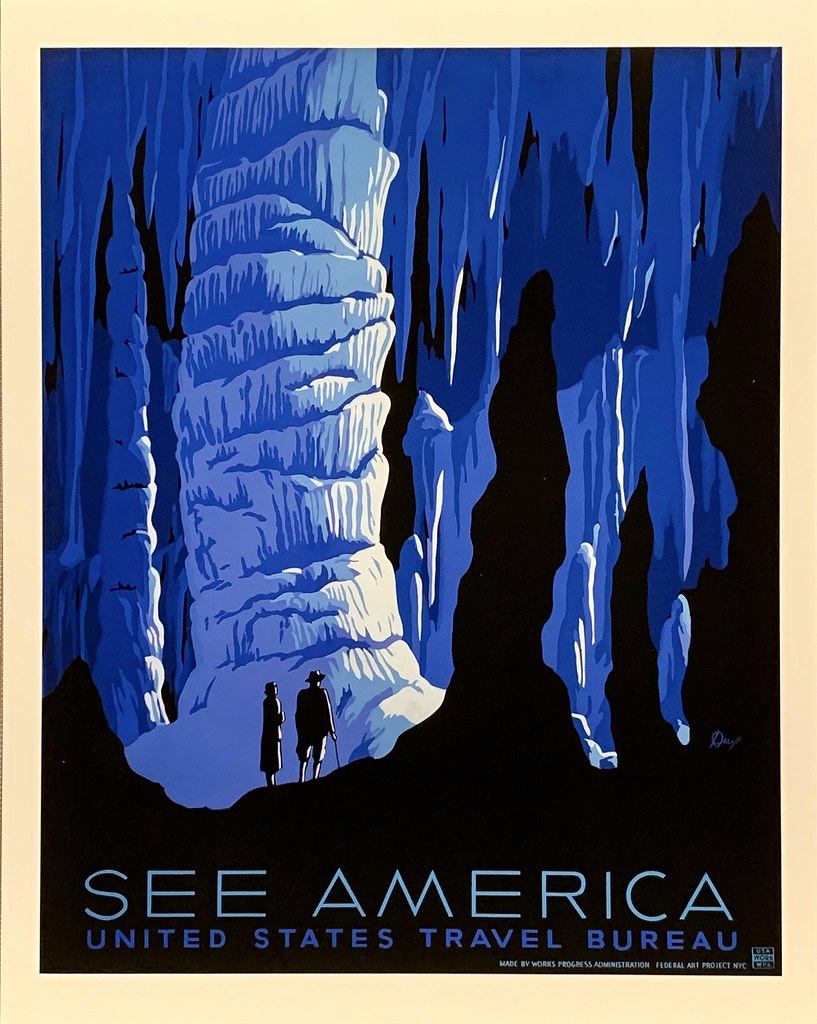#Federal Art Project
Text

This is a fresco mural entitled "The New Deal," by Conrad Albrizio, depicting various phases of that program. It was unveiled in the auditorium of the Leonardo Da Vinci Art School on January 24, 1935. President Franklin D. Roosevelt, architect of the New Deal, is standing in the center.
Photo: Associated Press
#vintage New York#1930s#Conrad Albrizio#mural#Federal Art Project#New Deal#FDR#Jan. 24#24 Jan.#fresco#Great Depression#Federal Art Project mural
60 notes
·
View notes
Text
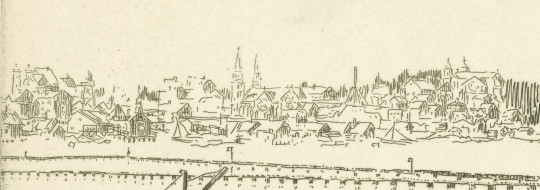

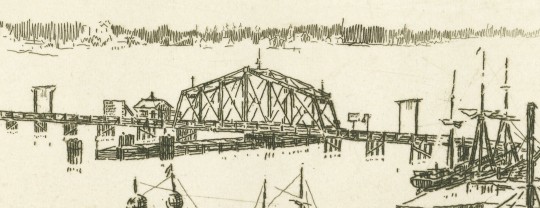


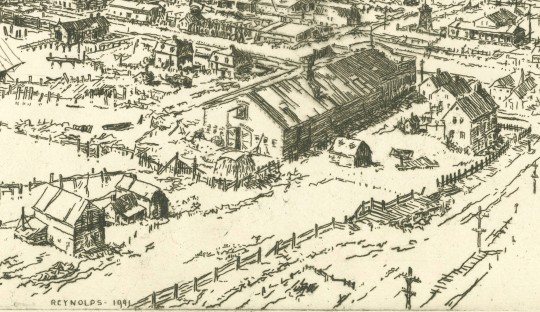

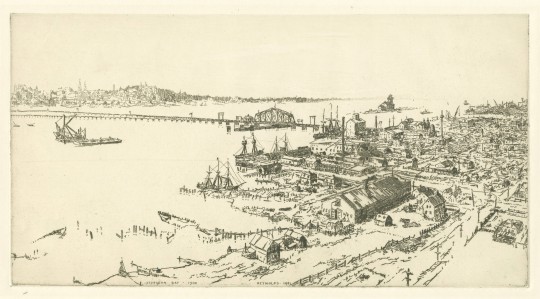
Old Sturgeon Bay, Wisconsin, 1900
Wisconsin architect and printmaker Charles Clark Reynolds (1893-1969) produced this etching of the Door County port city of Sturgeon Bay for the Federal Art Project of the WPA in 1941. Reynolds, who was born in Sturgeon Bay, ran a successful architectural firm with offices in Manitowoc and Green Bay, Wisconsin from 1920-1934. Andrew Stevens, curator emeritus of prints, drawings and photographs at the Chazen Museum of Art at the University of Wisconsin-Madison, made these observations about another copy of the print at the Wisconsin Historical Society in his 1998 exhibition catalog, 150 Years of Wisconsin Printmaking:
The print's title and the notation on the plate that identifies the image as being "Sturgeon Bay 1900" suggest a nostalgic purpose for the work. Instead of presenting the city as it was when the print was made in 1941, he looked back forty years, perhaps by reference to photography, to present if at the turn of the century [as Reynolds himself would have known it as a boy]. As if to reference further the retrospective stance of the work, there is a pencil notation in the print's margin that identifies it as having been printed on antique paper. This retrospective aspect of the work . . . may also reflect some of the historical goals of other projects of the WPA.
Our copy of the print is part of a portfolio of prints from the Wisconsin WPA, and this image is from a digitized version of that print from our digital collection Wisconsin Arts Projects of the WPA, which was made possible with generous financial support from The Chipstone Foundation.
View other posts on prints by Charles Reynolds.
View more posts from our Wisconsin Arts Projects digital collection.
#Old Sturgeon Bay 1900#Sturgeon Bay#Wisconsin#etchings#Charles Reynolds#Charles Clark Reynolds#Federal Art Project#Works Progress Administration#WPA#Wisconsin Arts Projects of the WPA#Andrew Stevens#digital collections#intaglio prints#Wisconsin artists
65 notes
·
View notes
Text
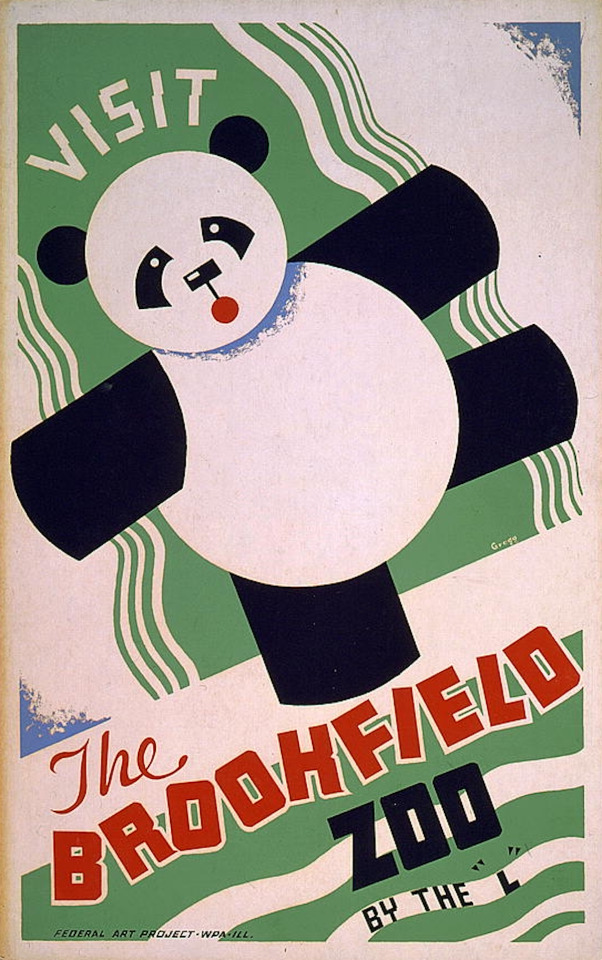
Federal Art Project poster. Visit the Brookfield Zoo. Between 1936 and 1938.
Library of Congress
#panda#posters#wpa#federal art project#animals#graphic design#new deal#chicago#bookfield zoo#nemfrog#1930s
224 notes
·
View notes
Text

7 notes
·
View notes
Text

Employment and Activities poster for the Federal Art Project (November 1, 1936.)
"The Federal Art Project (1935–1943) was a New Deal program to fund the visual arts in the United States. Under national director Holger Cahill, it was one of five Federal Project Number One projects sponsored by the Works Progress Administration (WPA), and the largest of the New Deal art projects. It was created not as a cultural activity, but as a relief measure to employ artists and artisans to create murals, easel paintings, sculpture, graphic art, posters, photography, theatre scenic design, and arts and crafts. The WPA Federal Art Project established more than 100 community art centers throughout the country, researched and documented American design, commissioned a significant body of public art without restriction to content or subject matter, and sustained some 10,000 artists and craft workers during the Great Depression." (source)
4 notes
·
View notes
Text
#america#usa#american art#graphic design#graphic art#blue#cavern#united states travel bureau#cave#underground#beautiful#art#vintage art#american vintage#blog#tumblr#new mexico#carlsbad caverns#alexander dux#federal art project#WPA#WPA Federal Art Project
2 notes
·
View notes
Text
Artifact Road Trip - Nevada

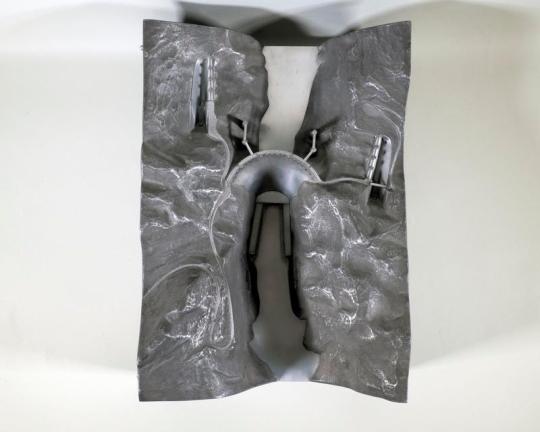
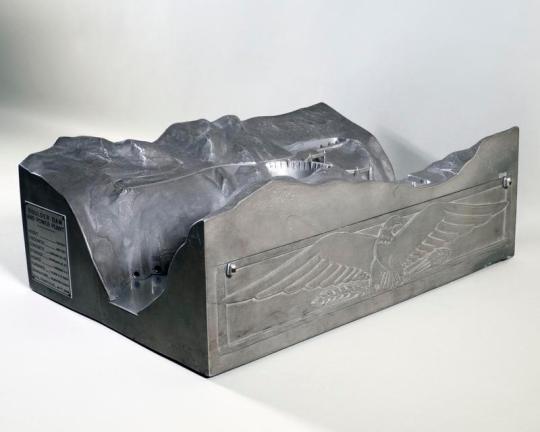
This model of the Boulder Dam, now known as the Hoover Dam, was one of several copies. It was given to President Roosevelt by the Denver Office of the Bureau of Reclamation through Elwood Mead, Commissioner, on December 10, 1935. The artist, Gladys Caldwell, was a sculptor for the Federal Arts Project.
Find out more about this Artifact Road Trip model on our Digital Artifact Collection: https://fdr.artifacts.archives.gov/objects/885
Follow along each week as we feature a different artifact in our Museum Collection from each of the United States.

#nevada#artifact road trip#hoover dam#boulder dam#fdr#franklin d. roosevelt#museum from home#federal art project
13 notes
·
View notes
Text

Title: A young man's opportunity for work, play, study & health / Bender ; made by Illinois WPA Art Project, Chicago.
Creator(s): Bender, Albert M.
Date Created/Published: Chicago : Illinois WPA Art Project, [1941]
Summary: Poster promoting the U.S. Civilian Conservation Corps showing a young man with pickaxe.
Source: LoC
#civilian conservation corps#CCC#New Deal#1930s#Great Depression#wpa poster#federal art project#1940s#1941#1940s poster#John M. Bender#library of congress
3 notes
·
View notes
Text

Moses Soyer’s oil painting, Young Girl, is one of the works on view in A New Deal: Artists of the WPA from the CMA Collection at Canton Museum of Art. The exhibition is a reminder of one of the best social programs ever created by the US government and the positive impact it had on the country during one of its hardest periods.
From the museum about the exhibition-
Against the backdrop of severe economic strife caused by the Stock Market Crash of 1929, President Franklin Roosevelt created the Works Progress Administration (WPA), which put roughly 8.5 million Americans, including more than 173,000 men and women in Ohio, to work building schools, hospitals, roads and more. Within the WPA was The Federal Art Project (FAP) which provided employment for artists to create art for municipal buildings and public spaces. The FAP had a non-discrimination clause that meant it attracted and hired artists of color and women, who previously received little attention in the art world. The only guidance the government offered about subject matter was to depict the “American scene” and stipulated no nudity or political issues. The goal was for artists to help the United States develop its own distinct American style of art, especially as artists in other parts of the world were forbidden freedom of expression and ordered to create artworks that projected the beliefs of their governments.
Though the WPA artists in the United States shared the common goal of capturing life in all its variety and promoting national pride, they each had different approaches, and many modified their typical subject matter to fit whatever project they were assigned. The arts before and after the New Deal relied on private patronage and the philanthropy of wealthy and elite institutions: galleries, museums, dealers. But during the WPA, art wasn’t a luxury good, it was seen as an essential part of our democracy. Artists were seen as professional workers who were making important and significant contributions to American life. The artworks made under the WPA became the collection of the American people and were put in public collections – hospitals, schools, post offices, housing projects, etc. – ensuring they were part of communities. The arts were seen as an important part of a democratic society and the American way of life, with a richness of experience and accessibility to culture.
While artists were offered opportunities through the WPA, they were far from immune to the distress caused by the Depression, and many still struggled to make a living. Will Barnet detailed a bleak scene he came across, saying:
“It was like a war going on. There were bread lines and men lined around three, four, five, six blocks waiting to get a bowl of soup. It was an extraordinary situation. And one felt this terrible dark cloud over the whole city.”
Moses Soyer also described the hardships artists experienced, saying,
“Depression–who can describe the hopelessness that its victims knew? Perhaps no one better than the artist taking his work to show the galleries. They were at a standstill. The misery of the artist was acute.”
The FAP supported the creation of thousands of works of art, including more than 2,500 murals that can still be seen in public buildings around the country. The FAP also supported art education and outreach efforts, including traveling exhibitions and art education programs for children. The WPA and FAP had a significant impact on the American art scene, and many of the artists who participated in the program went on to become important figures in the art world.
A New Deal: Artists of the WPA from the CMA Collection highlights the lives of artists from our Permanent Collection who worked for the WPA, and in doing so, fostered resilience for a struggling nation. You will learn about the projects they worked on, the subjects they were interested in, and how their own lives were affected by the Depression. Each of these artists helped to foster the nation’s spirit and prove that even in the darkest of times, art serves as a uniting force to collectively lead people into a brighter future.
And about Moses Soyer and his painting from the museum-
The Depression set the mood for most of Soyer’s art expression, and his portraits of people seem to be preoccupied with a sad secret. His portraits were often of solitary fi gures, using professional models or his friends, capturing in these paintings the spirit of his sitters, their dreams or disillusionment. He is best known for his introspective fi gure paintings of weary, melancholy women in muted colors, matching the mood of his sitters with the pigment in his paint. He was inspired by artist Edgar Degas, who used color expressively.
On the museum’s website you can find both the artwork on display for the exhibition and also a gallery of the museum’s entire collection organized into several categories.
#Moses Soyer#Art#Canton Museum of Art#Art History#Art Shows#Canton Art Shows#Works Progress Administration#Drawing#Federal Art Project#President Franklin D. Roosevelt#Franklin D. Roosevelt#Government Programs#Great Depression#History#Ohio Art Shows#Painting#The New Deal#WPA
0 notes
Text

Halloween Roller Skating Carnival poster, 1936. WPA, USA.
#halloween#retro#1936#wpa#federal art project#poster#poster art#humor#costume#graphic design#typography#art deco#moderne#central park
0 notes
Text

“Oh what if the code tricks Jaiden pretending to be Bobby” OKEY AND WHAT ABOUT JAIDEN’S EMPATHY FOR THE REJECTED? HER ABILITY TO FIND THE GOOD IN THE SO CALLED EVIL HUH??!!
I cannot be stopped somehow I’m gonna found family my way to death
#fanart#digitalart#art#qsmp fanart#qsmp#qsmp code monster#code entity#qsmp Jaiden#q!jaiden#qsmp Bobby#and yes in the project bluebird au I would make Jaiden choose between her federation family and her island family#MY ANGST IS BASED AROUND LOVE AND ACCEPTANCE#my art
2K notes
·
View notes
Text

In 1937, the WPA's Federal Art Project commissioned Japanese-American artist Eitaro Ishigaki to paint two murals for the Harlem Courthouse. It was part of an ambitious project for murals all over the city; in the end, there were about 400 designs, although many were never painted.
Ishigaki's murals, American Independence (above) and Emancipation, received a hostile reception in the community. In 1938 the City Council branded them "offensive" and removed them. (That may be some Council members taking notes, above, March 31, 1938.) It's unclear whether they were preserved.
Other Harlem murals included work by African-American artists.

Top photo: Associated Press via Shutterstock
Bottom photo: Smithsonian Institution
#vintage New York#vintage Harlem#1930s#Eitaro Ishigaki#Harlem Courthouse#Federal Art Project#public art#Work Progress Administration#murals#art#art history#Harlem murals#Federal Art Project murals#art controversies#March 31#31 March#Mar. 31
47 notes
·
View notes
Text



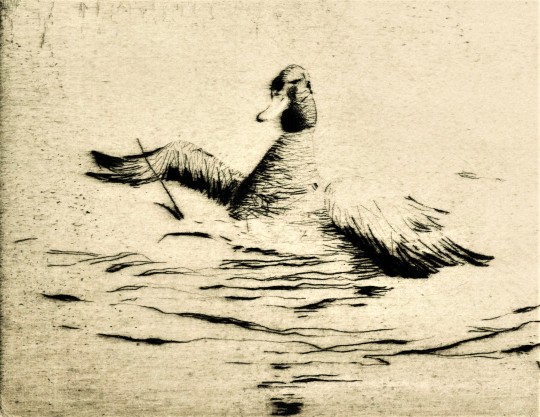

A Mallardy Feathursday
This Feathursday, we turn again to our digital collection Wisconsin Arts Projects of the WPA for this etching entitled Mallards made in the late 1930s or early 1940s by Wisconsin architect and printmaker Charles Clark Reynolds (1893-1969). The print was scanned from a portfolio of original prints in Special Collections labelled Making a Woodcut, which as we noted yesterday contains many more printmaking techniques than the woodcut.
Charles Reynolds ran a successful architectural firm with offices in Manitowoc and Green Bay, Wisconsin from 1920-1934. He produced this and many other etchings as part of his service in the Federal Art Project of the WPA.
The Wisconsin Arts Projects of the WPA digital collection was made possible with generous financial support from The Chipstone Foundation.

View more posts from our Wisconsin Arts Projects digital collection.
View more Feathursday posts.
#Feathursday#Mallards#ducks#etchings#intaglio prints#Charles Clark Reynolds#Charles Reynolds#Wisconsin artists#Federal Art Project#WPA#Works Progress Administration#Making a Woodcut#Wisconsin Arts Projects of the WPA#birds#birbs!#digital collections
43 notes
·
View notes
Text

Art classes for children. 1940. Federal Art Project poster.
Library of Congress
107 notes
·
View notes
Text

9 notes
·
View notes
Text


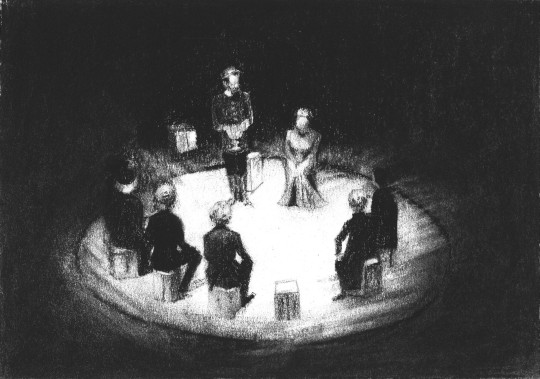
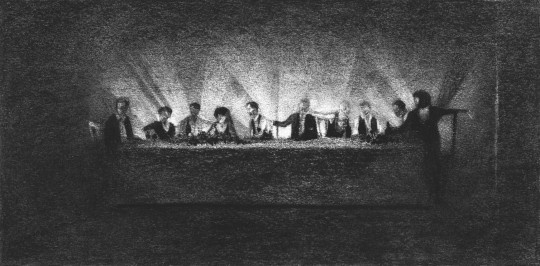
Macbeth, Act III: Scene 4
Carla Salas, 2023
1939, Macbeth, Copley Theatre, Boston
1946, Macbeth, Shakespeare Memorial Theatre, Stratford-upon-Avon
1976-1978, Macbeth, The Other Place, Stratford-upon-Avon
2011 - present, Sleep No More, The McKittrick Hotel, New York
#macbeth#shakespeare#william shakespeare#theatre#scenography#charcoal#charcoal drawing#art#punchdrunk#royal shakespeare company#federal theatre project#sleep no more#scenic design
95 notes
·
View notes
